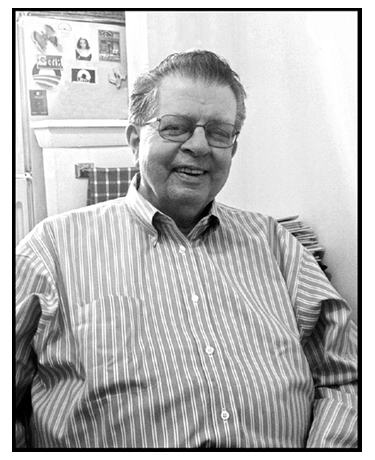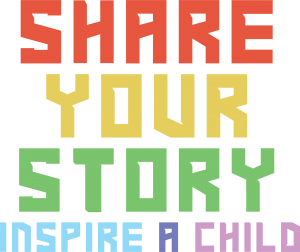INTERVIEW WITH JAMES CROSS GIBLIN
“What an Editor’s Job Is”:
An Interview with Jim Giblin at home, spring 2012
By Roger Sutton, Editor in Chief, The Horn Book Inc. ©Roger Sutton
Roger Sutton: I hear from Mary Downing Hahn and others about what you have done for them. How you guided them, how you helped them. How you brought them into the world, sort of. Who brought you in? Who helped you?
Jim Giblin: There were a variety of people, and some of them have nothing to do with publishing. My college drama teacher – I majored in dramatic arts in undergraduate-a woman named Nadine Miles, a fascinating woman and a good director. She wasn’t the kind to say, “Enter upstage left, take three steps downstage, make a right turn, say your line as you cross to the sofa, and sit down.” Miss Miles let us fumble around through the blocking. But once you got that right moment, she would direct it very closely. You’d have an insight into the whole performance. I played, when I was nineteen years old, an aged Russian sage in Gorky’s play The Lower Depths. It was mainly set in the basement of a rundown apartment house in Moscow. Miss Miles didn’t stop me until I rose from a bench, and she stopped and said, “Wait a minute. How old are you?” And I said, thinking in those days when I was nineteen, that sixty-five was ancient, I said that, and she said, “All right. But don’t you think his bones might be a little creaky? After all, he’s trudged all across northern Russia before getting to Moscow with his strange religious vision. Would he jump up from the bench, or would it be hard for him to stand up? Why don’t you try it again?” We tried it a couple of times more until she was satisfied. I edit that way. I’ve never been the kind who would mark up the author’s manuscript with a lot of changes or suggestions. I always felt that it would freeze up the writer just as it froze up me.

And I also was fortunate to work on an early job in publishing as an assistant editor with Beatrice Creighton at Lothrop, Lee & Shepherd, long gone now as a separate imprint. Bea Creighton had a real knack for picking out a picture book manuscript, and seeing the core of an effective text. It just needed paring, usually. She published Alvin Tresselt’s Caldecott-winning White Snow, Bright Snow. Roger Duvoisin was the illustrator. My favorite story, though, about her and Alvin, was with Hide and Seek Fog, also illustrated by Duvoisin. I was on the staff of Lothrop when that went through production and I well remember the day when the associate art director came rushing in with final proofs just before it was going on press. Patsy, the art assistant, said, “Miss Creighton, Miss Creighton, look at this spread.” Bea didn’t see anything wrong with it and said, “Well, it seems to read smoothly to me.” Patsy replied, “But don’t you realize, they left off the whole text on page twelve?” So Bea looked at it again, and she said, “You know, this text always needed cutting.” And it was published and it became a Caldecott Honor book. It was a tone poem, Hide and Seek Fog, about the fog coming in on a New England beach community. The kids all have to stay inside and they’re annoyed at that, but then the sun comes out, and guess what, they’re all playing happily on the beach again at the end. Bea was a pioneer of that genre, the mood picture book, which Jane Yolen, among many others, has carried on. Owl Moon, I think, is a mood picture book. Bea had a strange sense of humor sometimes, and sometimes she annoyed authors, but most of them loved her, because she saw what they were trying to do and helped them do it. That’s what an editor’s job is.
RS: Do you find, working with authors, that Author A has a consistent tendency to write too much or too little? Do you know, coming into a manuscript by someone you’ve worked with for a long time, what you need to watch out for?
JG: Mary Downing Hahn, in her earlier days, had a tendency to underwrite. And the wonderful thing about Mary-and it’s certainly not true of every writer-is that she would learn from her mistakes. If she made a set of revisions after my saying, “Let the character go more. Let her really explode in the scene. Let her go at it with her mother,” the wonderful thing about Mary was she always took the suggestion in her own direction, ending up in a much better place than I would ever have imagined.
RS: It’s interesting to me that the metaphors you use to talk about what you thought Mary needed to do are very stagecrafty. Do you think there’s a connection with your drama background?
JG: Very much so, yes. I’ll even say to an author, “Give her a stronger entrance.” How does she bring up the mail to her aged grandfather? Is there any way she makes it seem like it might be interesting or exciting news? The character, I mean. Mary’s been a wonderful author to work with because she has grown. I took several – I won’t say which ones – but several early manuscripts of hers because I had faith in her development.
RS: She told me she thought you published her first book just to get her over it.
JG: Well, that’s partly true. Mary has a wicked sense of humor when she lets it go.
RS: I saw in another interview with you that Mary, Eve Bunting, and Marion Dane Bauer all came in over the transom. Most children’s publishers today won’t look at unsolicited manuscripts. They’re counting on agents to filter the process for them. Do you think that there might be a better way for how publishers handle manuscripts from new writers?
JG: I believe firmly in at least taking a look-a quick look-at unsolicited submissions. Especially in the case of SCBWI writers. Mary told me that she’d attended a writers’ conference that I spoke at in the seventies-before she ever submitted anything to anybody. She later saw me at another conference and wanted to say hello, but, she said, “So many people were flocking around you, and I just didn’t think you’d feel you needed to meet me.” Well, I would be willing to bet that two- thirds or more of the people that were flocking around me had no talent whatsoever. The pushy ones almost never did. You know, the ones who would come up and say, “I have just one little question.” Or one “tiny” question. And there was the man in Houston who followed me into the men’s room with a shoebox. He stood next to me at the urinal and said, “Would you take a look at my novel?” And I said, “Not here.” “Well, could I send it to you in New York?”
RS: Is there anything you see in publishing today that you envy?
JG: I’ll say a good word for marketing. Certain books that they see potential in-and I don’t always agree with them about just which ones – they work harder to promote. Once I had been in the field for a decade or so, I often felt that nobody knew what they were really doing in terms of marketing. It was easier then, of course, because the key markets for trade publishers then were schools and libraries. Clarion was fortunate, too, because Marjorie Naughton, who retired last year, had joined the firm. I hired Marjorie in 1972, and she retired at the end of 2010.
RS: The field seems more cutthroat today.
JG: Oh, it’s much more cutthroat. I was once quoted as having said, and I don’t even remember this but I guess I did, that in the adult field it’s dog-eat-dog, and in children’s books it’s bunny-nibble-bunny. It isn’t that way anymore.
RS: What is probably the most important lesson that your editing career brought to your writing career?
JG: That’s a good question, and I want to think a little bit. Well, for one thing, I hope it taught me how not to be a demanding son-of-a-bitch with my editor.
RS: “Here comes Jim again.”
JG: Yes, exactly. You know, a lot of authors have very unrealistic expectations of what their books are going to do. I think they have even more unrealistic expectations today because there’s so much stress on marketing at writers’ conferences. And really, the author, especially a little-known author, has very little control over his or her career in terms of publicity or marketing. They can make themselves really obnoxious by wondering why nobody invites them to be on television. Or some Clarion book has been mentioned in People magazine, and the other authors ask, “How could I get my book into People magazine?” There’s been a lot of encouragement of self-publicizing in recent years because speakers at conferences will say the marketing people only have time to concentrate on their star people, so you have to find your own way to publicize your book. If that means being aggressive, you have to learn how to be aggressive. I don’t know how that’s working out these days, but I don’t advise it as a course of action. Of course publishers spend more money on proven commodities, because they want to follow up a success with another success. And until you prove that you can deliver a successful book to the house, they’re not going to give you as much attention as they give their star people. I think that should be understandable to anybody.
RS: Even the star people are being pressured to do a new book that’s as much like their last successful book as possible. Sequels, companions, things like that.
JG: I’ve never thought that really good books come from that approach. But who am I to say, because one of our bestselling author-illustrators at Clarion is someone I still work with, and love working with, because she’s so imaginative and intelligent, and that’s Eileen Christelow and her five little monkeys.
RS: People love those five little monkeys.
JG: They do, and Eileen will ask me plaintively sometimes, “Can I take a break and do some other kind of story?”
RS: And what do you say?
JG: I say yes. She’s also published two books that I still think are among the best, What Do Authors Do? and What Do Illustrators Do?
RS: Have you found a difference in publishing your own books?
JG: I published my first book, The Scarecrow Book, in 1980. It’s been over thirty years now. There is more nonfiction publishing for the younger end now, and there’s much more use of color, especially color photographs, in series like Houghton’s Scientists in the Field.
RS: I love that series.
JG: It’s a fine series. It fills a real niche, I think, that nobody’s tapped before. Of course, nonfiction has gone through so many different phases.
RS: Kind of like books for boys, you know? It seems about every, oh, eight years or so, people say again, “Oh my God, we’ve got to do something about nonfiction.” Or, “We’ve got to do something about boy readers.” One or the other. Then you see more attention for a little while, and then it slowly recedes, and then it cycles back.
JG: Yes, exactly. My friend Russell Freedman lucked out, I think, with Lincoln: A Photobiography, because it came at the peak of a trend for recognizing nonfiction, including several nonfiction Newbery Honor books: Rhoda Blumberg’s Commodore Perry in the Land of the Shogun; Patricia Lauber’s Volcano: The Eruption and Healing of Mount Saint Helen’s.
RS: I remember your own early books as being concerned with social history.
JG: Yes, that was what I devoted my books to in the eighties.
RS: And now we see more biography from you.
JG: Yes, there was a definite shift. I, for better or worse, have always followed my own inclinations in the subjects I chose to explore, and editors have gone along with me. I don’t think if I were starting out today I would have as easy a time getting contracts for those earlier titles. I had a lot of fun writing those social history books, especially one called From Hand to Mouth, which is, I think, my funniest book.
RS: Let There Be Light: A Book about Windows, that’s my favorite.
JG: That one was the most demanding to write. And I think probably one of the more creative of them, because it was an unusual idea, and I had a lot of fun researching it and writing it. Those were books I could do comfortably while heading Clarion as editor-in-chief and publisher, because they’re what I call beads-on-a-string books. There’d be a theme, like in From Hand to Mouth, knives, forks, spoons, and chopsticks, and the table manners to go with them. I could research a segment or a bead of the story and write it. There was not a driving thrust through from beginning to end. With the biographies I started writing later I had to go deeper and be more concentrated.
RS: That’s a very interesting distinction between these two kinds of books.
JG: You think so?
RS: Well, because a biography demands more attention to the string! You can’t cherry-pick.
JG: No, and you can’t link up a few stray facts with a few more stray facts. When Plague Strikes was a pivotal book in my career, and one of the most popular. It’s not a biography, but in a way it’s a biography of three epidemics. I pushed individuals to the front of the story because I felt it made it more lively, and so you could feel the personal effects of the particular plague. But among my biographies is my own favorite, a Boston Globe-Horn Book Honor a few years ago, Good Brother, Bad Brother, the story of John Wilkes Booth and Edwin Booth. I think I did a pretty good job with Hitler, too (The Life and Death of Adolf Hitler, Clarion 2002)
RS: Are you attracted to the bad boys, Jim?
JG: Not in life, necessarily, but certainly in my writing. I think bad characters are just more fun to write about or watch in a movie.


